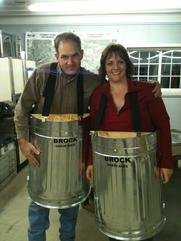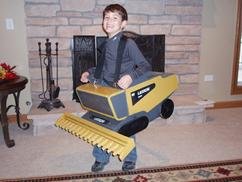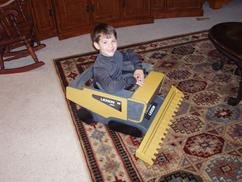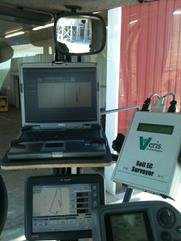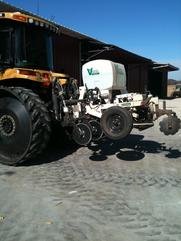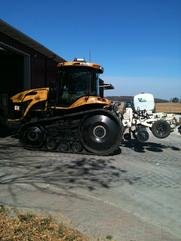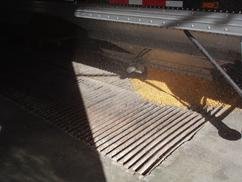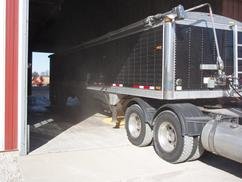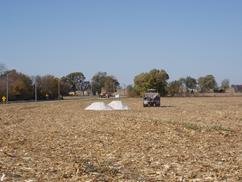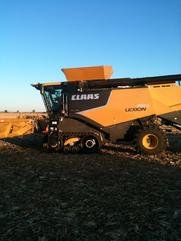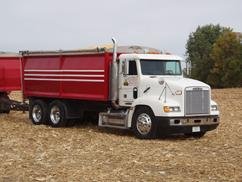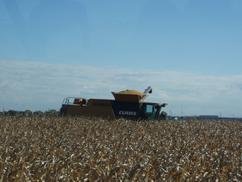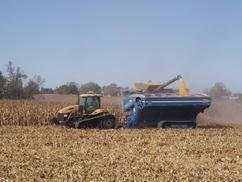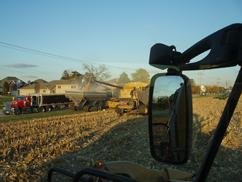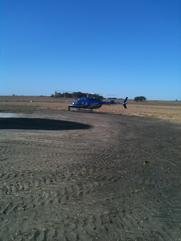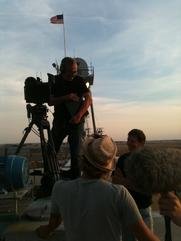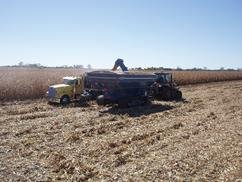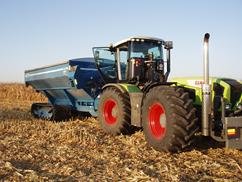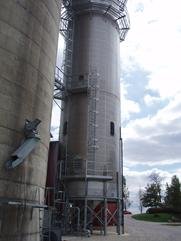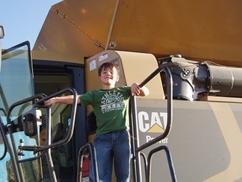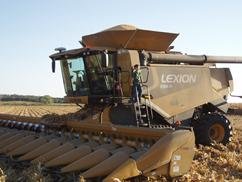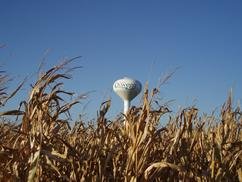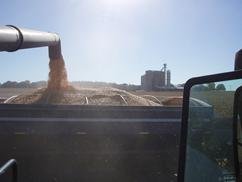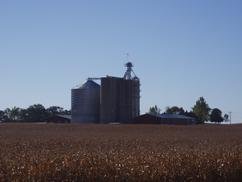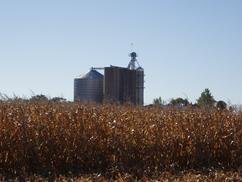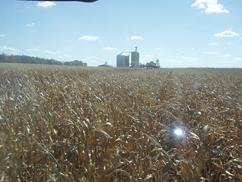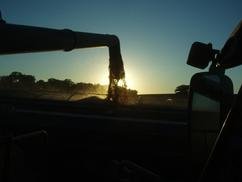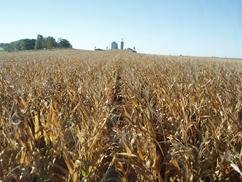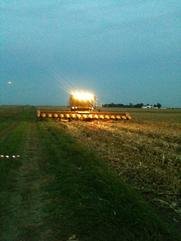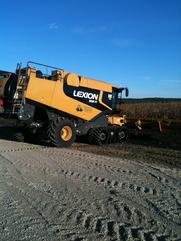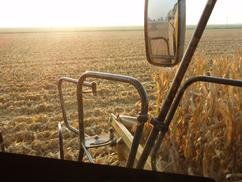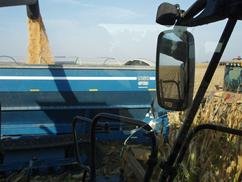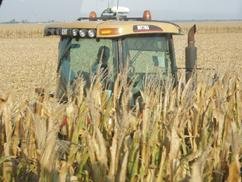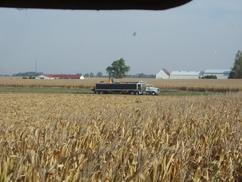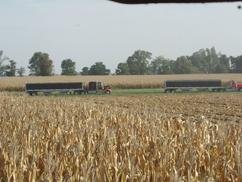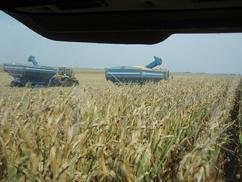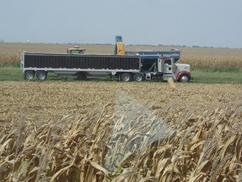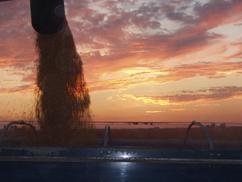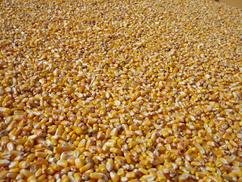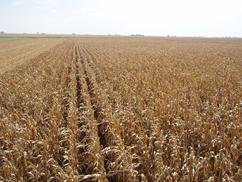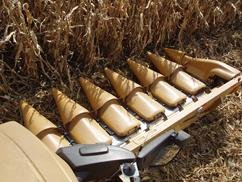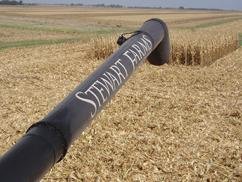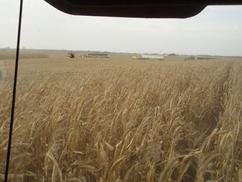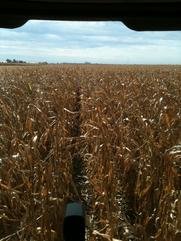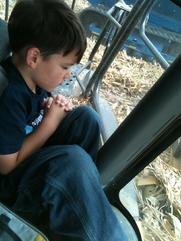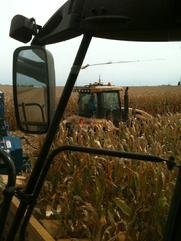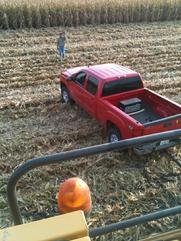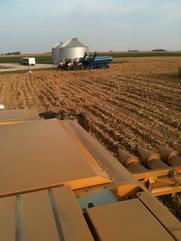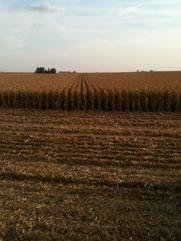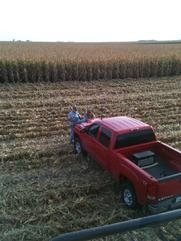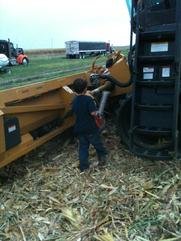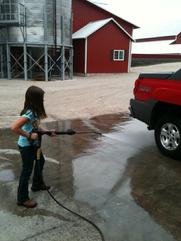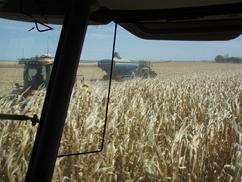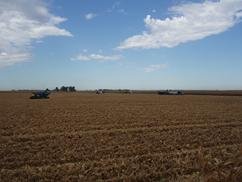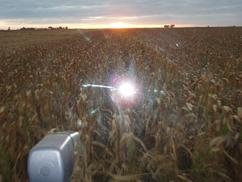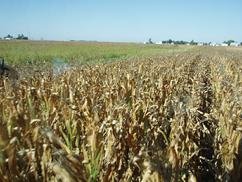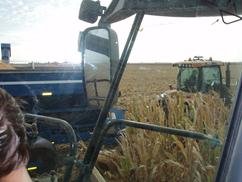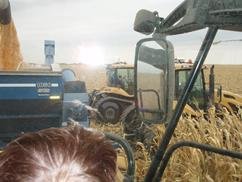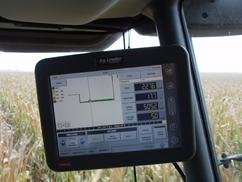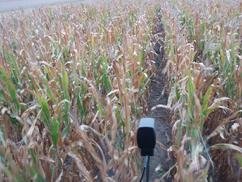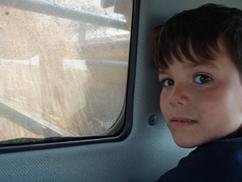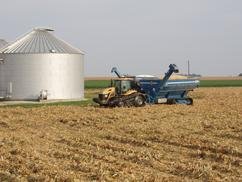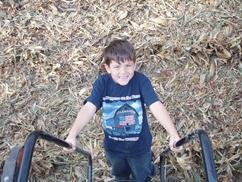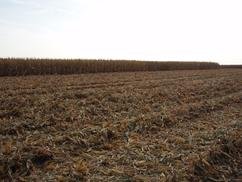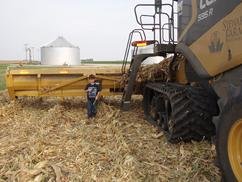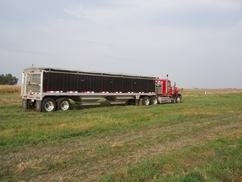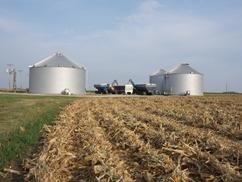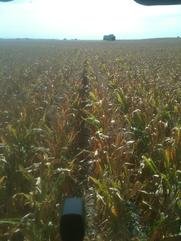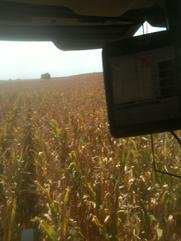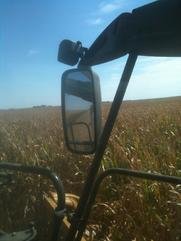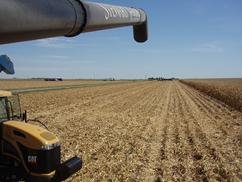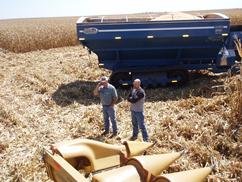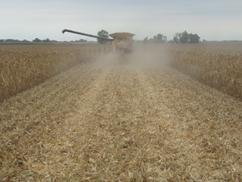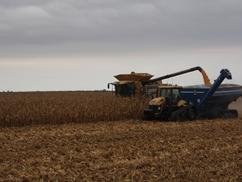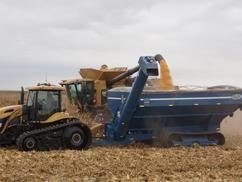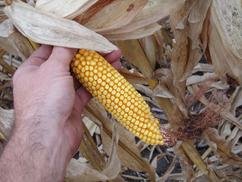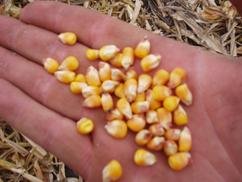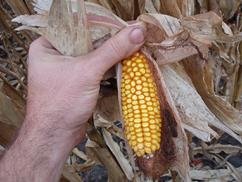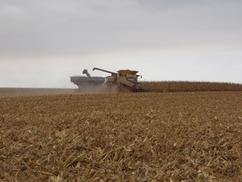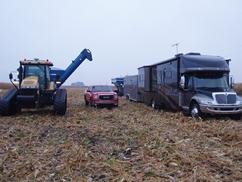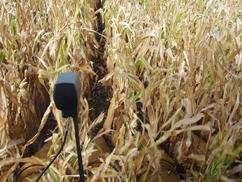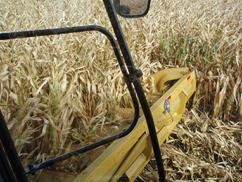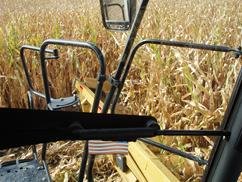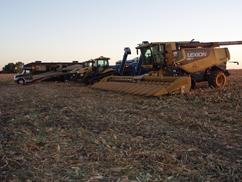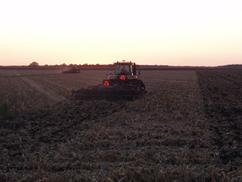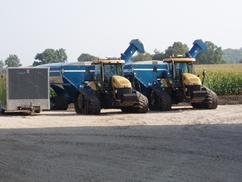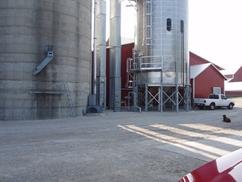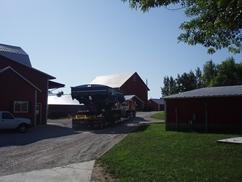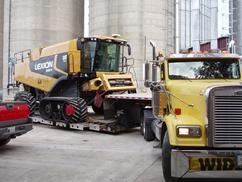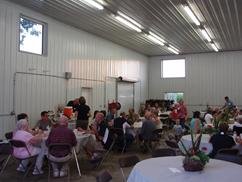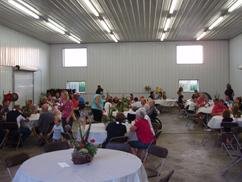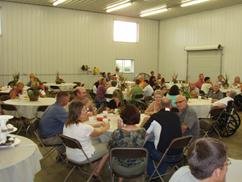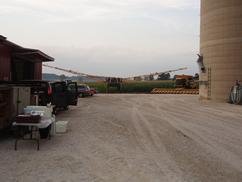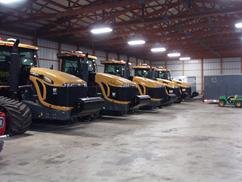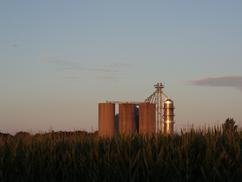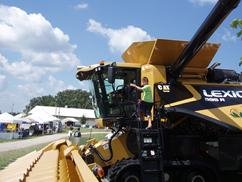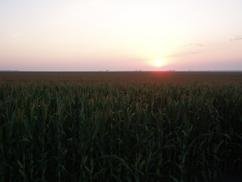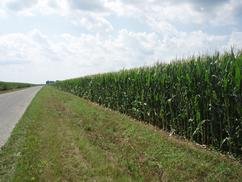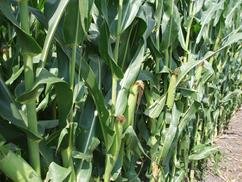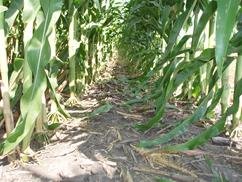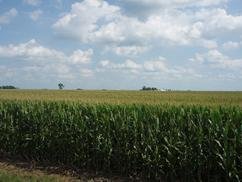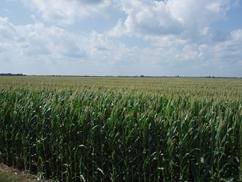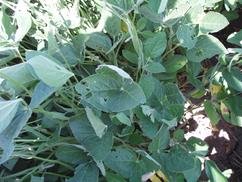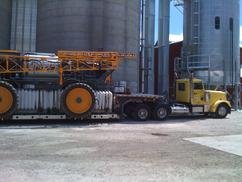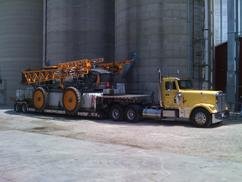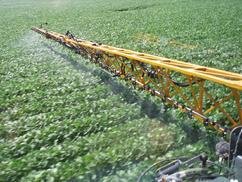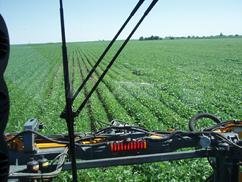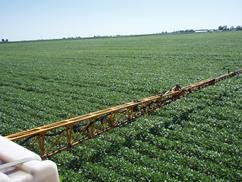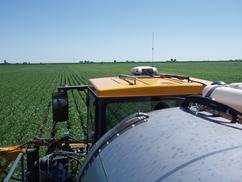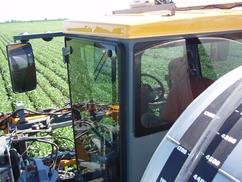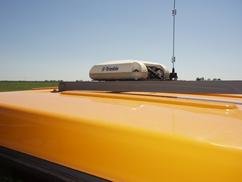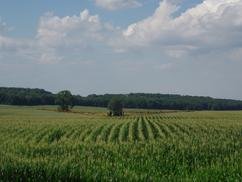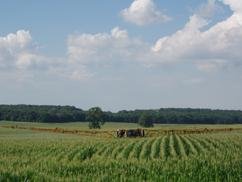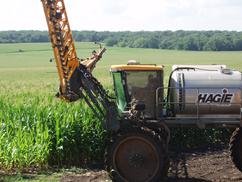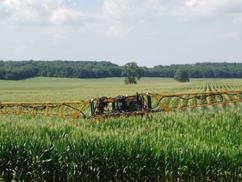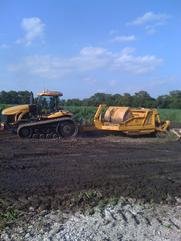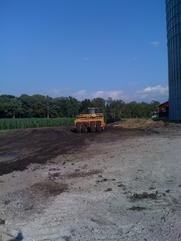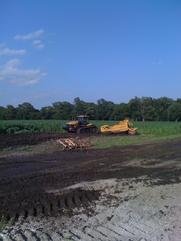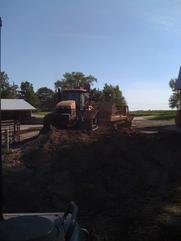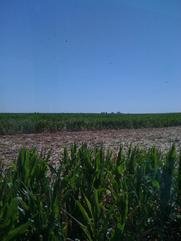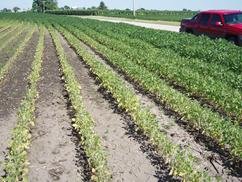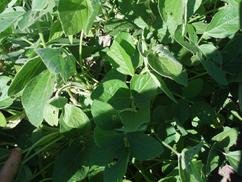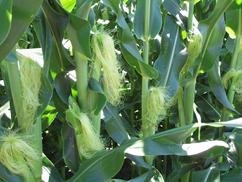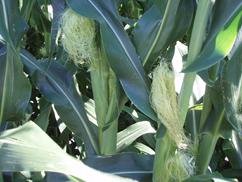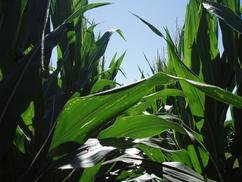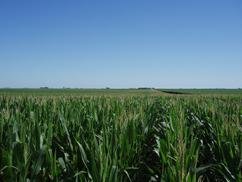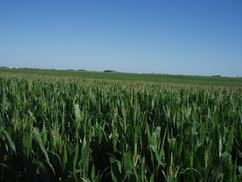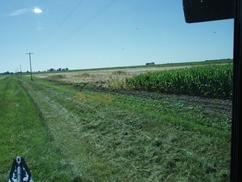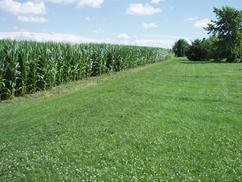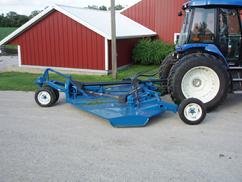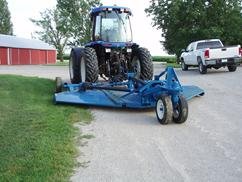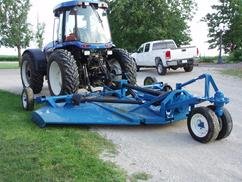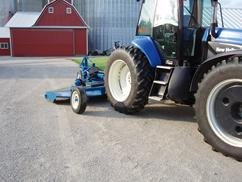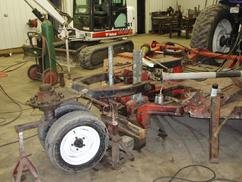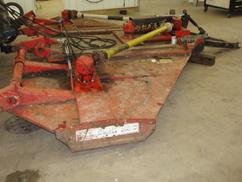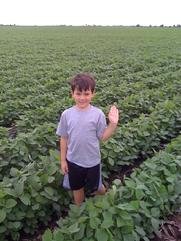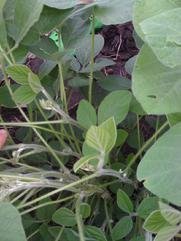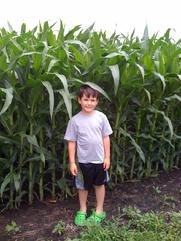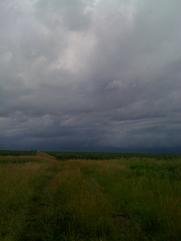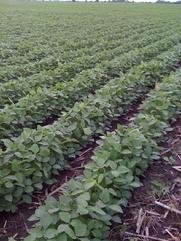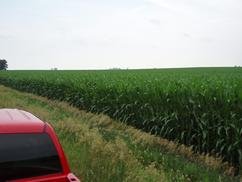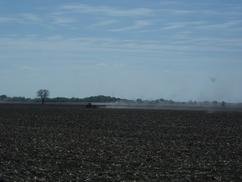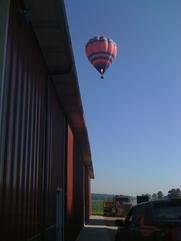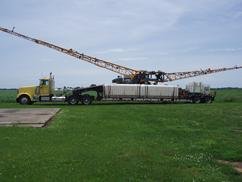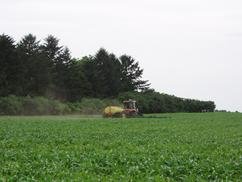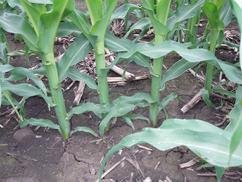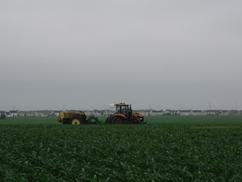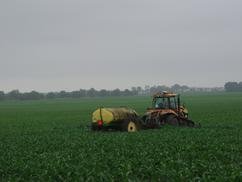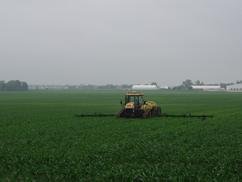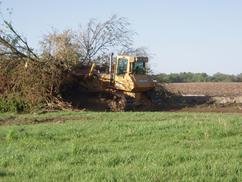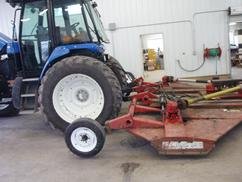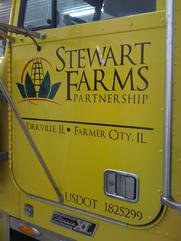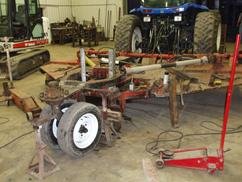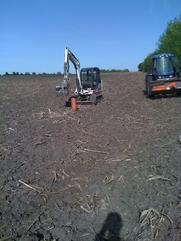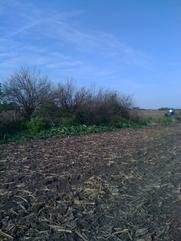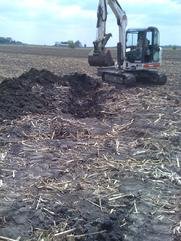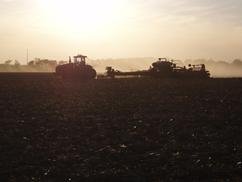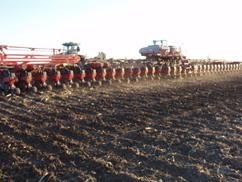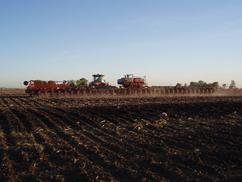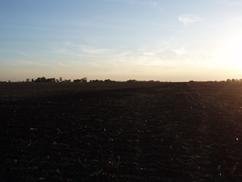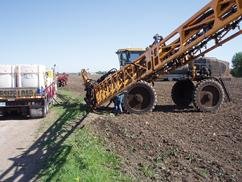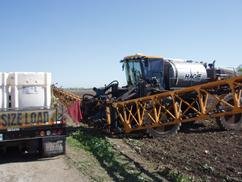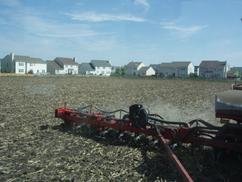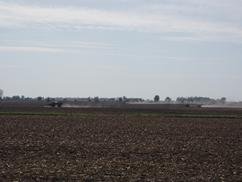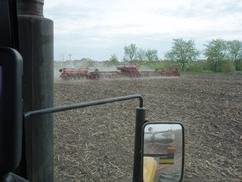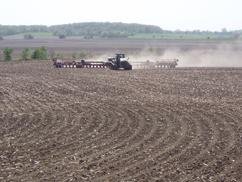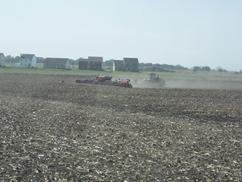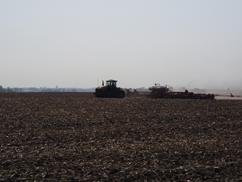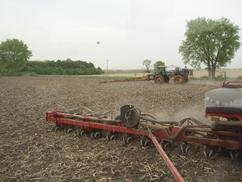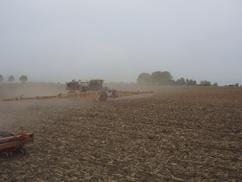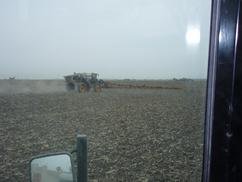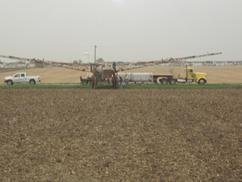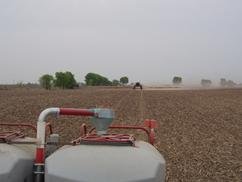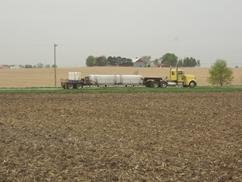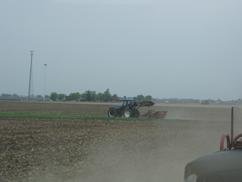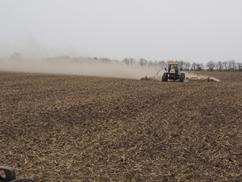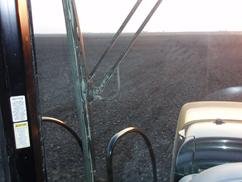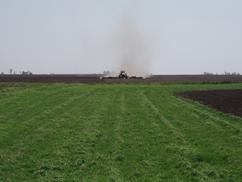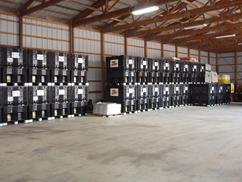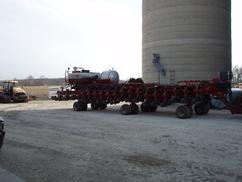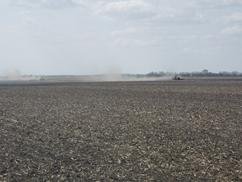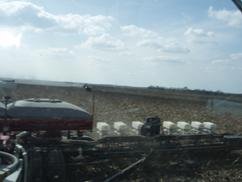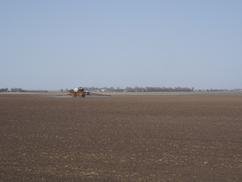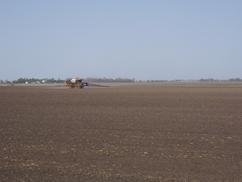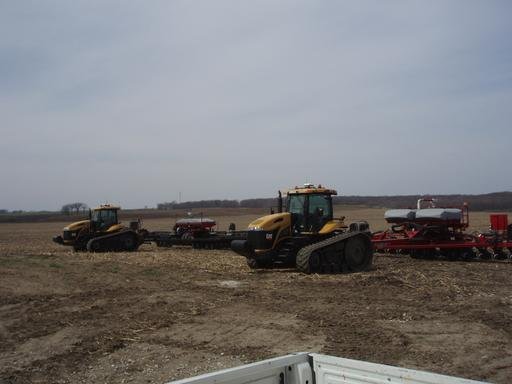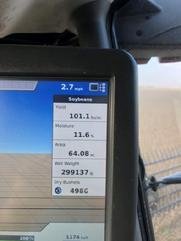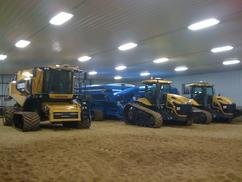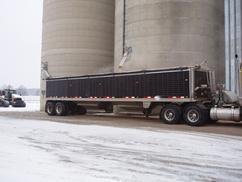2010 Crop Year
Harvest Season
November 2010
We continue to work on some field drainage projects in Farmer City. We are using tandem scrappers behind one of our Cat MT875s to install surface drainage. One of the challenges is that the fields have very little slope, so getting the water to drain them in the correct direction is tough. We are using GPS to control the scrapper elevation.
With harvest wrapping up early this year, we have had some time for a little fun this fall. Below are some of the costumes we had for a Halloween party dressed as grain bins and a class project that young Keith had dressed as a combine.
Week Ending October 23
With harvest now done, we are focusing on fall tillage work. Both Krause rippers are running long days and trying to get over the rest of the ground while the conditions are still dry. The rippers are pulling harder as we have moved east. We had been running 6 mph, but we are now down to 4 mph as we have gotten into more compacted soils.
We are trying a Veris soil testing machine. The Veris will do ph soil tests on the go and record the data with GPS. The advantage of the Veris over hand-pulled samples is that we are taking over 5 samples per acre vs. 1 every 2.5 acres. We also get the results on the go vs. waiting for lab results. We are running the Veris at 10 mph on 60-foot swaths. The Veris also takes Electric Conductivity (EC) tests on the fly. This data helps define the management zones in the fields. Below is a video of the machine running.
We have applied a lot of limestone this fall. With the wet conditions last fall, we did not get much applied, so we had twice as much to apply this fall to catch up with our soil pH management. Limestone applications should be wrapping up this week.
Week Ending October 16
We finished harvesting on Saturday, October 16. This is the earliest we have ever finished. What a difference a year makes. Last year we were barely started by this date, and we did not finish until early December due to wet ground and wet corn conditions.
Yields continued to be good on the fields we harvested this week. However, there were wide variations in yields within the fields due to drainage issues and hybrid differences. Some hybrids handled the excessive summer rains well, while others did not. Side-by-side comparisons showed yield differences of up to 50 bushels per acre between hybrids.
Corn moisture levels continued to be very dry to the end, with most corn less than 15%. One of the reasons we were in a hurry to get the rest of the crop out was our concern that moisture levels would continue to fall and we would see grain losses in the field.
The corn plant health continued to be excellent through our last field harvested. Nearly all the plants were still upright and looking very good to the end. There were even some green leaves remaining in some of the plants despite the fact that the corn kernel moisture was dry. We attribute this good plant health to the application of fungicide in mid-summer.
Now that harvest is complete, we will focus our full attention on getting caught back up with tillage and limestone applications. The tillage crew is in high gear and making good progress.
Below are some photos from this week’s work. We were able to test out a new Lexion 760 combine this week along our machine. It performed well, and it has many enhanced features like a newly designed cab, light package, and residue management system that make it attractive. We will be considering upgrading our machine to a new model later this year.
Week Ending October 9
The incredible stretch of great harvest weather continued this week, allowing us to run now for 5 weeks in a row with no harvest delays caused by the weather. Corn yields continue to be good; however, we are finding some areas impacted by excess summer rains as we move to the east into Will County. We are now 90% done with harvest.
We enjoyed working with the marketing department from Claas this week as they filmed scenes of the new Lexion combine working in some of our fields. The film crew, along with the helicopter buzzing our fields, added some excitement to our week. The Claas people were great to work with, and we are looking forward to seeing how their marketing materials turn out. Check out the new Lexion combines at Claas of America.
In addition to bringing out a new combine to use in the videos, the Claas people also brought out a Claas Xerion tractor which has a rotating cab. We had to try it out on a grain cart to see if we could run it backwards to load carts. Our method needs some refinement, but we gave it a shot.
Below are some videos and pictures of this week's work and fun.
Week Ending October 2
We had another good week of harvesting. We have now been running for 4 weeks straight, and we have had an unbelievable stretch of good weather. We have not yet missed a full day of running because of bad weather. What a difference a year makes. Last year we were not started yet due to the high moisture levels in the crop.
We continue to find corn yields at or above our expectations around Kendall County. Excessive summer rains impacted some of the lower-lying fields but not to the extent that our central Illinois fields were. Moisture levels continue to run 17 to 20%, with most corn now running less than 18%. The new dryer (installed last fall) is not getting much of a workout, which is OK.
Much of the corn we picked this week still had good plant health, as evident in the remaining green leaves and straight stalks. We are attributing this good health to the fungicide and fertilizer applications we made at pollination time. Yield checks so far show a 20 bushel per acre advantage where we sprayed fungicide over not treated areas.
Below are some photos and videos from this week's work.
Week Ending September 25th
We finished up corn harvest in the Farmer City area on Thursday, September 23rd. We held off on harvesting what we thought would be our best fields to the end, and we were not disappointed. Most of the corn we harvested in the last week stayed above 200 bushels per acre which was a great improvement over some of the fields we found earlier in the season. Not surprisingly, our best yields came from fields that were well drained and had fall tillage done early last year before field conditions got too wet.
Late last week, we got the harvesting machinery moved back up around home, and started corn there on Saturday. So far, yields have been good, with field averages around 200 bushels per acre. Moisture levels have been around 17%.
The tillage crew made good progress early last week in the Farmer City area. Rains that came late in the week have stalled progress on that front for a couple of days.
It is nice to be back around home, sleeping in our own beds, and getting to spend a little more time with family.
Week Ending September 18
We had a full week of corn harvesting with no delays for rain. Yields continue to be highly variable depending on how severely the fields were impacted by standing water in June. Fields with a little slope and outlets for surface water are yielding much better than those that lay flat and have poorer drainage. Corn on soybean fields is performing better than corn on corn. Our corn on soybean fields is yielding over 200 bushels per acre, while many of the corn on corn fields are much lower. However, it is hard to make a direct comparison since our corn on soybean fields are some of our best-drained fields.
We will start harvesting our soybeans around the Farmer City area next week. We have heard reports of some very good soybean yields, and we are looking forward to how ours perform.
We had a little excitement this week when one of our grain carts got caught up in a power line. Luckily no one was hurt, and very little equipment damage was sustained.
The tillage crew is making good progress and nearly keeping up with the combine. The ground continues to work up very nicely with the dry soil conditions. They are running right behind the limestone-spreading trucks. Many fields are getting limestone applications this year. Brandt's Consolidated is spreading the limestone based on soil tests we ran last year. Limestone is spread on the fields to offset acidic conditions found in the soil. We soil test and spread limestone on 2.5-acre grids across the fields.
My son Keith was able to ride along with us on Saturday. He enjoyed his first combine ride for the season and got to see some of the best corn we have harvested to date this year.
Below are some photos and videos of this week’s harvest. As a word of warning, Keith's video is not the most stable production.
Week Ending September 11
We started the 2010 corn harvest on Tuesday, September 7th, in the Farmer City area. Yields have been highly variable. Field averages have ranged from less than 150 to 190 bushels per acre. Moisture levels have ranged from 16 to 24% depending on the hybrids. The better yields are coming from the fields that are better drained.
With excellent planting conditions, the early planting date, and fairly good early-season weather, we were expecting higher yields this year. The low yields appear to be the result of excessive rains in late June that flooded out some of the low areas and stunted much of the corn, combined with excessive heat and dry conditions in August while the crop was maturing. As shown in the photos below, many of the ears are short, with aborted kernels on the end. The crop aborted the kernels late in the season. The kernels that did make it are very small as a result of poor weather conditions in the kernel filling time during August.
Weather and field conditions were good this week, and we were able to make good progress with the harvest. We have been able to get over 270 acres per day with one combine. We are again running a Lexion 595R machine with a 16-row head. The good thing about having poorer-yielding corn is that we can run faster, but I would rather be running slower in better corn. We feel fortunate that we are getting as good of yields as we are since there are reports around the state of yields much lower than we are seeing.
The tillage crew got started later in the week. With the dry soil conditions, the fields are working up nicely. We are running two Krause Dominators this year. We usually run them together in the same field using GPS steering to maintain their working widths.
After putting in several long days, we took Sunday off to go home, go to Church, and get in some family time before we hit it hard again on Monday.
Below are some photos and videos from this week’s harvest.
Spring & Summer Work
September 4th
All the machinery is now in place and ready for harvest in the Farmer City area. Corn moisture levels have been dropping and are now below 25% for most hybrids. 2-3 inches of rain fell in the area in the middle of this week, delaying our start on harvest until next week. Early yield reports from the area have been a little disappointing. Excessive rains in the early part of the growing season combined with hot/dry conditions later in the season may have cut yield potential this year.
Below are some shots of the machines getting ready for the trip south to start corn harvest.
August 21
My family and I got away for a quick trip to the West this past week. We toured through South Dakota and Wyoming, hitting the main sites at Custer State Park, Yellowstone, and the Grand Tetons. We enjoyed seeing a lot of beautiful scenery and up-close views of wildlife. However, after 3200 miles of driving and it is good to be back home and sleeping in our own beds. Now it is back to school for the kids and back to getting things ready for harvest for the rest of us.
August 10
We had our annual farm appreciation BBQ this week. Each year we invite the people we do business with for an open house at the farm and BBQ dinner. This year we had over 100 guests. We are grateful to the many landowners, suppliers, grain buyers, neighbors, and others who help make our farm successful.
August 4
We are getting equipment and grain facilities ready for harvest. With the early corn planting and good growing conditions we have had this summer, we are expecting harvest to start in early September. The corn continues to look good despite some heavy rains and winds in the north. Areas around Kendall County have had over 12 inches of rain in the past week.
Last week we spent some time at the Kendall County Fair. We had a combine and tractor at the fair that kids could explore. We had a lot of visitors at our exhibit, including many adults with good questions about farming. It was a worthwhile event. I think we helped give many people a better understanding of modern agriculture and the equipment used.
Next week we will be hosting our annual farm appreciation BBQ for many of the people we do business with, which means we will be busy this week getting the farm cleaned up for the event.
July 20 -- Corn College
This week Brad and I attended Farm Journal's Corn College in Bloomington. The sessions were well done and helped to reinforce the importance of some of the farming practices we are doing now. The importance of managing soil pH was emphasized at the conference. With the wet conditions last fall, we had to postpone some of our limestone applications to manage soil acidity. We hope to get all of the necessary limestone applied this fall.
We applied some of the new things we learned by scouting fields on the way home. Below are some of the current field conditions.
July 13 -- Fungicide spraying
We have been busy spraying corn and soybeans. We are spraying all of the corn this year with fungicide. The warm and wet conditions this summer are ripe for the development of diseases in the corn, including leaf blights and stalk rots. We are spraying the corn with Quilt fungicide along with Coron foliar fertilizer to give the corn another shot of nitrogen. All of the corn and beans to the south are now sprayed. We started spraying in the north today. Below are some photos of the spraying progress.
July 10 -- Moving dirt
We are in the process of getting a tractor and scraper set up to do some land leveling and waterway maintenance this fall. We have been using the equipment to level out the drive area around the new grain facility this week. Below are some photos.
July 4 -- Crop Conditions
Crop conditions remain good. We did end up losing 20+ acres of corn in the Farmer City area to standing water. All of the corn is now pollinated or in the process. We replanted some soybeans in the Farmer City area that were lost to high water. Below are some pictures of the good and the bad of the current conditions.
June 26
The front-mounted mower project is now complete. As we mentioned in an earlier posting, we redesigned an old Bush Hog pull-type mower into a front-mounted mower on a bi-directional tractor. The completed machine, along with a new paint job, is shown below. We have started using it, and it works very well. It maneuvers nicely, and you have a full view of the mower deck as you mow. The mower is 15 feet wide with its original folding wings. We added the pivoting tandem wheels in the front. The lift system was modified so that it lifts with the front and back wheels. We also modified the drive lines so that the PTO could be driven from the back of the mower. This required adding a gearbox and drive shaft to get power to the rear of the machine.
The project took us a little longer than we expected, but it was a fun challenge to make it work.
Week Ending June 25th
Heavy rains and wind this week caused some crop damage near Yorkville. The crop still looks good, but we will lose some of the lower areas to flooding. We had some damage to buildings due to the high winds but nothing major.
Most of the corn is now past shoulder high. Corn in Farmer City is 3 leaves from tasseling. Soybeans in Farmer City are flowering. Pictures from some of our crop scouting trips from the past week are below.
Week Ending June 13
We were busy this week side-dressing nitrogen and spraying corn for weeds. All of the side-dressing is now done, and the spraying is nearly complete. We used liquid 32% nitrogen for side-dressing. We only had about 700 acres to side-dress. All of the other corn had 100% of its nitrogen needs applied in the winter and spring.
We have been getting rain nearly every day, which slowed up field activities. Heavy rains caused some yellowing of the corn in low areas of the fields. Some small areas flooded out, but so far, we have not lost much corn to excess water.
Below are some photos of this week’s activities.
Week Ending May 22
For the last couple of weeks, we have been cleaning up the planters and spring tillage equipment. We are cautiously optimistic that we will not have to get the equipment out again to do any replanting this year. Despite some heavy rains over the last couple of weeks, the crops look good, and we lost very little to standing water.
With the return of clear skies and warm temperatures this coming week, we are hoping to get back to spraying soybeans for the first pass of weeds. We planted most of the soybeans no-till back in April without a burndown application of herbicide. The weeds are coming now and need to be sprayed ASAP.
We have been working on cleaning up some old farm building sites. Pictures of that work are below. Thanks to KR&G Excavating for to use of their Deere dozer.
We have an engineering challenge we are working on in the machine shop. We are taking an old pull-type 15-foot Bushog mower and making it into a front-mount mower on a tractor. We are now going to attach the mower to the tractor's 3 pt hitch and push it from the back end of the mower. To do this, we are going to have to reconfigure the PTO drive line, add caster wheels to the front end, and modify the lift system. It should be a handy mower when it is done, but it will be a challenge to make it all work. Pictures of the project so far are below.
Finally, we have been working on updating the logos on all of our machines. Pictures of the updated equipment signs are below as well.
Week Ending May 1st
We finished planting on Thursday, April 29th. All the corn and soybeans are now in. This is the earliest we have ever completed planting. We have been blessed with some very good weather and soil conditions so far this year. We were only rained out for a couple of days since we started planting.
The early planted corn is now up and looking good in Farmer City. 1.5 inches of rain fell there over the week, which will get that corn off to a good start.
The first round of spraying is now nearly complete. We had to shut down for a few days this past week because of the high winds.
We spent some time this week cleaning out old fence lines and fixing broken drainage tiles. These are usually jobs we do before planting starts, but with good early planting conditions, we got the crops in first and are now getting back to field boundary and tile maintenance.
Our attention will now turn towards scouting the crops and staying ahead of the weeds and bugs.
Below are some pictures of this week's work.
Week Ending April 24th
We had another good planting week. We finished up both corn and soybeans in central Illinois early in the week and moved machines north to start planting corn around Yorkville. As of this weekend, we are past halfway completed planting in the north.
Brad and the rest of the spraying crew were able to catch up with the planters by the end of the week. He is applying a 1/2 rate of Harness Extra herbicide and 20 gallons/acre of 28% nitrogen to give the corn a second shot of nitrogen fertilizer. He is spraying right behind the planters and running autosteer to stay off the corn rows.
One field operation that we have in the north that we don't have in the south is "rock picking." Many of the fields we have in the north are blessed with rocks that are big enough to cause damage to the equipment if you don't get them picked up. Gavin was on rock detail this week with the loader and rock picker shown in the photos below. This is better than picking them up by hand like we used to do, but it still takes time.
We are running into a high level of residue left from last year's crop that did not break down over the winter. A combination of the late harvest and weather conditions over the winter caused the stalks to not break down as much as usual. The field cultivators are getting through the stalks fine, and the row cleaners on the planters are clearing away the trash in the row, but it is a little more challenging than usual. Some of the fields had an excessive amount of root/dirt balls. We worked these with a rotary harrow which did a good job of breaking up the dirt clods and making a good seed bed.
We received 1/2 of rain in the north over the weekend. That should help the corn that was planted in dry conditions. We should be able to get back in the fields early this next week.
Below are some photos of the fieldwork this week.
Week Ending April 17th
Thanks to some good weather and long hours, we had a very productive week in the fields this past week. We started planting corn in Farmer City on Monday night (April 12). Field conditions were very good all week, and we were able to get nearly all of the Farmer City area corn in by Saturday night.
We started planting soybeans in Farmer City on Friday. It is early for bean planting, but the soil temperatures and conditions are good, so we are going ahead. We hope to get done with beans early next week.
We started moving machinery back to the north on Saturday to get planting started around Yorkville.
Below are some pictures of the field operations from this week.
April 8
We finished hauling all of the corn out of storage this week. Our goal was to get all of the corn delivered before we started planting, and we made it. Thanks to the excellent work of the trucking crew. They have delivered over 600,000 bushels of corn since December.
Below is a shot of the last load leaving the farm on this cloudy April day.
April 3
We were able to get into the fields this week to start doing fieldwork. We were able to disk some of the corn stalks down that we were not able to get to last fall. Field conditions were dry enough to work ground in the north but still somewhat wet in Farmer City.
We have started moving machinery down to the Farmer City farms to be able to start planting down that way. We hope to get started planting sometime next week.
We now have two planters ready to go as soon as the weather is fit.
Winter Activities
We have been keeping busy through the winter working on equipment in the shop, delivering grain to market, attending seminars to learn new ideas, and trying to get in some family time in the off-season. Check back here for our progress on these activities and more throughout the winter.
March
Nearly all of the 2009 corn in storage is now hauled to the grain elevators and other customers. Our goal is to have all of our on-farm storage cleaned out before planting begins.
We have been busy getting the corn planters and other spring equipment ready to go.
February
We rebuilt our corn head and cleaned up the rest of the harvesting equipment. We resurfaced all of the knife rolls on the corn head, replaced all of the gathering chain bearings, and repainted the head. All of the equipment should be ready for harvest in 2010. Now on to getting the spring equipment ready.
January 10-16 TEPAP
Bob participated in The Executive Program for Agricultural Producers (TEPAP). This was a week-long training and development session in Austin, Texas. Topics at the seminar included financial management, human resources, and growth strategies. Attendees at the seminar included producers from around the country, Canada, and Australia. It was very beneficial to get to know producers from other areas and to discuss business issues with them. We hope to implement several of the ideas I gained from TEPAP into our business. See TEPAP for more information on the program.
Cleaning up equipment
Keith (6) helps wash up the combine. He got a little dirty and wet that day.
Hauling grain out of storage
We have been hauling grain to the container market for export and to Corn Products in Chicago for processing.

